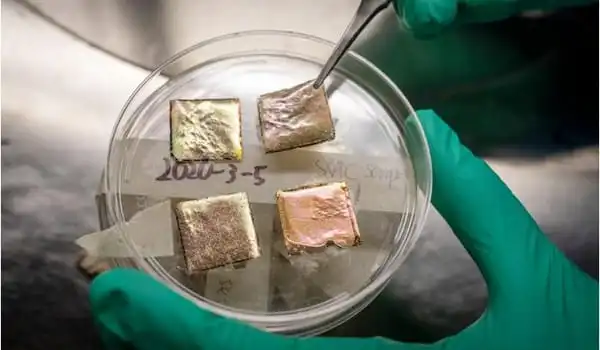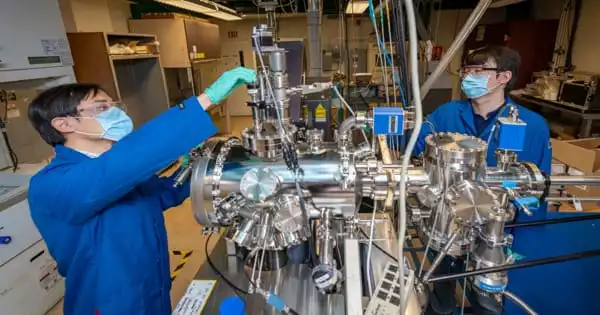Scientists have created an all-season smart-roof covering that keeps homes warm in the winter and cool in the summer – all while using no natural gas or electricity. The findings of a study published in the journal Science point to a game-changing technology that beats existing cool-roof systems in terms of energy savings.
“Depending on the outside air temperature, our all-season roof coating automatically adjusts from keeping you cold to keeping you warm. This is a system that provides both air conditioning and heating while using no energy and emitting no emissions” The project was conducted by Junqiao Wu, a faculty scientist at Berkeley Lab’s Materials Sciences Division and a UC Berkeley professor of materials science and engineering.
Cool roof systems, such as reflective coatings, membranes, shingles, or tiles, feature light-colored or darker “cool-colored” surfaces that reflect sunlight to cool homes. Some of the absorbed solar heat is also emitted as thermal-infrared radiation by these systems; in this natural process known as radiative cooling, thermal-infrared light is radiated away from the surface.
Wu stated that the difficulty with many cool-roof systems is that they continue to emit heat in the winter, which raises heating bills. “Our novel material, known as a temperature-adaptive radiative coating, or TARC,” he explained, “may provide energy savings by automatically turning off the radiative cooling in the winter, eliminating the problem of overcooling.” TARC is the first roof coating that automatically switches between cooling in hot weather to warming in cold weather by regulating its rate of radiative cooling.
Depending on the outside air temperature, our all-season roof coating automatically adjusts from keeping you cold to keeping you warm. This is a system that provides both air conditioning and heating while using no energy and emitting no emissions.
Junqiao Wu
A roof for all seasons
“A few years back, I wondered whether there was a material that could automatically convert from radiative cooling in hot weather to heat retention in cold winter,” he explained. “Then I realized vanadium dioxide can do that.”
Metals are excellent conductors of both electricity and heat. Wu and his colleagues discovered in 2017 that electrons in vanadium dioxide act like a metal to electricity but an insulator to heat; in other words, they conduct electricity well but not much heat. “This behavior differs from that of most other metals, in which electrons transport heat and electricity correspondingly,” Wu explained.
Vanadium dioxide is also transparent to (and so not absorbs) thermal-infrared light below around 67 degrees Celsius (153 degrees Fahrenheit). When vanadium dioxide reaches 67 degrees Celsius, it transforms into a metal and absorbs thermal-infrared light. The ability to flip from one phase to another – in this case, from an insulator to a metal – is a property of a phase-change substance.
Wu’s 2017 study discovered that by substituting only 1.5 percent of the vanadium in vanadium dioxide with tungsten, a method known as “doping,” the material’s phase-change threshold is reduced to 25 degrees Celsius, or 77 degrees Fahrenheit – an optimum temperature for real-world applications.
Wu and his colleagues created a 2-centimeter-by-2-centimeter TARC thin-film device with three layers: a reflective bottom layer made of silver, a transparent middle layer made of barium fluoride, and a top layer comprising ordered blocks of vanadium dioxide “islands.”

TARC “looks like Scotch tape” and can be applied to a solid surface, such as a rooftop, according to Wu. The current study shows vanadium dioxide’s exceptional all-weather versatility in a TARC thin film and compares it to the performance of a commercial dark roof coating and a commercial white roof coating.
Last summer, co-lead author Kechao Tang set up a rooftop experiment at Wu’s East Bay house to illustrate the technology’s potential in a real-world setting. Over the course of many days, a wireless measurement device installed on Wu’s balcony continuously recorded reactions to variations in direct sunlight and outside temperature from a TARC sample, a commercial dark roof sample, and a commercial white roof sample.
How TARC outperforms in energy savings
The researchers then used the data from the outdoor experiment to simulate how TARC would perform year-round in cities representing 15 different climate zones across the continental U.S.
Wu recruited the assistance of Ronnen Levinson, a co-author on the study and the leader of the Heat Island Group in Berkeley Lab’s Energy Technologies Area, to help them fine-tune their model of roof surface temperature. Levinson, who has spent nearly three decades researching the technology, benefits, and policies of cool surfaces such as reflective roofs, walls, and pavements, developed a method to estimate TARC energy savings from a set of more than 100,000 building energy simulations previously performed by the Heat Island Group to evaluate the benefits of cool roofs and cool walls across the United States.
Wu’s team used this strategy to forecast the annual energy savings that TARC provides by lowering the need for both cooling and heating energy in the summer and winter. Finnegan Reichertz, a 12th grade student at Oakland’s East Bay Innovation Academy who worked remotely as a summer intern for Wu last year, assisted in simulating how TARC and the other roof materials would perform at specific times and on specific days throughout the year for each of the 15 cities or climate zones studied for the paper.
According to the simulation experiments, TARC outperforms existing roof coatings in 12 of the 15 climate zones for energy savings, particularly in regions with large temperature variations between day and night, such as the San Francisco Bay Area, or between winter and summer, such as New York City, the researchers report.
“With TARC deployed, the average US household may save up to 10% on electricity,” Tang said. Even in chilly weather, standard cool roofs have strong solar reflectance and thermal emittance (the ability to release heat by emitting thermal-infrared radiation).
TARC reflects approximately 75% of sunlight year round, but its thermal emittance is strong (about 90%) when the ambient temperature is warm (over 25 degrees Celsius 77 degrees Fahrenheit), encouraging heat loss to the sky. TARC’s thermal emittance automatically shifts to low (approximately 20%) in cooler weather, helping to retain heat from solar absorption and indoor heating, according to Levinson.
The calculations were validated by results from infrared spectroscopy studies performed using advanced technologies at Berkeley Lab’s Molecular Foundry. “Simple physics indicated TARC would work, but we were amazed at how effectively it worked,” Wu added. “We had anticipated that the transition from warming to cooling would be gradual. Our simulations, outdoor studies, and lab experiments all proved otherwise, which is quite intriguing.”
TARC prototypes will be developed on a wider scale by the researchers in order to further assess their efficacy as a practical roof coating. TARC, according to Wu, has the potential to be used as a thermally protective covering to extend battery life in smartphones and laptops, as well as to protect satellites and cars from excessively high or low temperatures. It might also be made into temperature-regulating fabric for tents, greenhouse covers, and even hats and jackets.





